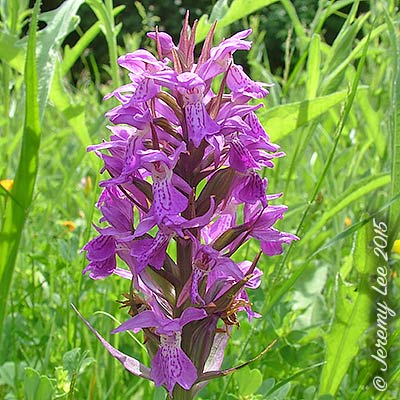
 |
|
Scientific Classifications explained » Amphibians » Ants » Aphids » Bees » Beetles » Birds » Bugs » Butterflies » Caterpillars » Damselflies » Dragonflies » Earwigs » Flies » Frog/Leafhoppers » Fungi » Galls » Grasshoppers » Harvestmen » Hoverflies » Lacewings » Ladybirds » Leaf Mines » Lichens » Mammals » Millipedes » Mosses » Moths » Sawflies » Slugs » Snails » Spiders » Trees & Shrubs » Wasps » Wild Flowers » Woodlice » Postboxes |
UK Nature > Wild Flowers > Red & Pink Wild Flowers > Dactylorhiza praetermissa

Common Name: Southern Marsh Orchid Scientific Name: Dactylorhiza praetermissa Dactylorhiza praetermissa, more commonly known as the Southern Marsh Orchid, is widespread and fairly common throughout Europe as far north as southwest Norway. In the UK it is locally common in the southern half of the country, less so in the southeast and north Wales, and absent from Scotland. It favours marshy ground and dune slacks, and often occurs with the similar-looking Northern Marsh Orchid (D.purpurella), which makes accurate identification tricky. The Southern Marsh Orchid typically reaches 30 to 50 cm tall although specimens up to 70 cm can occur. The leaves measure 10 to 20 cm long, are flat and usually unspotted. The conical flower spike, 5 to 10 cm long, bears 100 or more flowers, whose colours range from pale pink to dark magenta. Each flower has a broad lip, 9 to 14 mm across. This lip is gently rounded in D.praetermissa but more angular in D.purpurella. Flowers appear in late spring to summer, dependent upon the weather, but typically from June to July. |
|

https://www.uknature.co.uk is a website dedicated to showing the immense diversity of UK nature and wildlife. Our vast range of habitats, from lowland arable to snow covered mountains, from storm-ravaged coastlines to peaceful inland freshwater lakes and rivers, from dry, sandy heaths to deciduous and coniferous forests, all these habitats contribute to the abundance of UK nature. We have wild birds in huge numbers either residing or visiting our shores (597 recorded species as at July 2013) and we must also not forget the humble back garden with its grass lawns, flower beds filled with nectar rich flowers, shrubs and trees, all designed to attract huge numbers of insects such as bees, moths, butterflies and hoverflies; and finally the small ponds which provide safe havens for frogs, toads, newts and even slow worms and grass snakes. www.uknature.co.uk is the showcase for my personal passion, photographing uknature in all its glory. I sincerely hope you all enjoy the fruits of my labours. This site and all images contained therein is © Jeremy Lee 2004 - 2025. All Rights Reserved. Site design by Jeremy Lee. Site development & IT Support by Stuart Lee. |